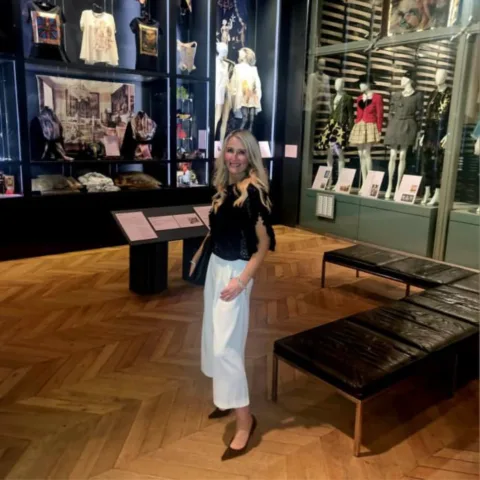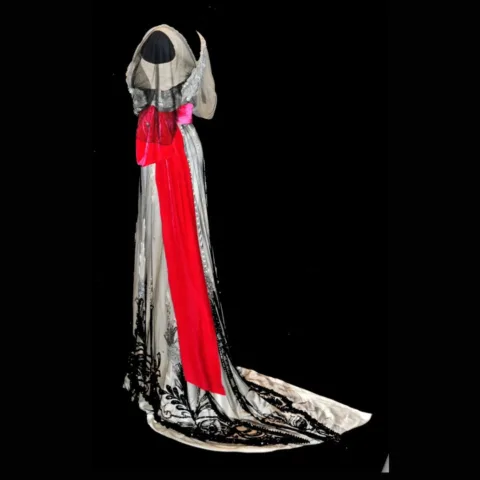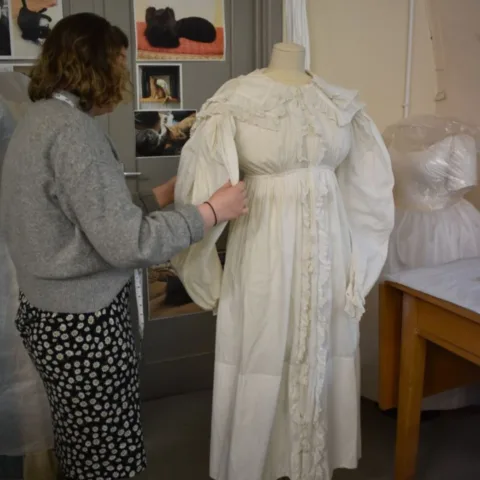The Bowes Museum Blog

Medicine for those Peaky Blinders blues
You can’t be a Peaky Blinders fan and not already have fallen in love with the fashion. From the iconic white club collar shirts and grey or brown suits for men to the less corseted but very glamorous fashion for the ladies, this show is much more than just an exciting drama with hot good hearted gangsters. For 5 seasons now they’ve kept us gasping with suspense and planning those Peaky inspired parties just so we can dress up like Grace or May Carleton.
During this era, fashion was trying to break away from the formality of the Victorian and Edwardian trends. Fashion trends for both men and women were trying to achieve a more free-spirited wear.
Peaky Blinders costume designer Stephanie Collie, in an interview with Clothes on Film website (clothesonfilm.com), said: “What I like about this period is that really, it could almost be now. Most of the clothes seen [on TV] wouldn’t look out of place. You can go out now and buy stuff like that, and wear it like that. I’ve said this before, but fashion always repeats itself. Three piece suits look good on everyone.”
We love fashion here at the Museum and are very fortunate to have a great fashion collection that was started by our founder Joséphine Bowes. Here we take a look at some of the items The Bowes Museum has which would not look out of place on the set of Peaky Blinders…

We can see Ada wearing this bell-shaped hat made from very lightweight straw called baku. The style of brim – wide at the front and narrowing round to the back – along with a high crown was a fashionable alternative in the 1920s to the 1908 invention, the cloche hat. This hat, which can be seen in the costume galleries, has a band of wool darning embroidery reaching over the front of the crown. The trim is in orange chiffon. Inside is the label ‘The Sagwen Hat’ London and Paris.
Miss Lucy Errington, who was an art mistress at Beverley High School, wore it together with the dress below, for speech day in 1925. She later donated it to the Museum and they can be seen today in the Fashion & Textiles Gallery.
If you think this ‘handluggage’ would be perfect for Polly, you would be right. Miss Lucy Errington, who donated the hat above, was by the looks of it a great crafter; in 1925 she hand made this dark brown leather, gorgeously decorated purse. This was not unusual as the ‘20s was a period when hobbies and handcrafted items were very fashionable and considered to have an authenticity of design which carried on from the 19th century Arts and Crafts movement.

This clutch bag was typical of the popular design at the time – square-shaped, with or without short wrist straps, and with tops which closed with a metal snap that was also decorated with carved designs of flowers, leaves or insects. Inside, there are two large compartments with a stud fastening fixed purse and a mirror pocket.

Although it is said never to ask what’s in a ladies bag, especially in a Peaky Blinders scenario, we are safe to say that handbags in the 1920s held only a couple of things. They were considered an accessory, completing the overall fashion look, instead of the practical use they have today. Things like lipstick, compact makeup, cigarettes (gasp!), a handkerchief and a comb would be on the list of items you could find. In some cases, a house key and a few coins would be found in a 1920’s handbag as well. Ladies who wore gloves would often carry a spare pair in their bag in case the ones they were wearing got dirty.
Did you know it was actually Coco Chanel who developed the idea of the shoulder bag? Although she showcased her first bag in 1929, it still followed a similar look as the one above, small with a short handle. As she did not like having to carry her handbag, in the following years she developed a new design, borrowing the idea of long straps from the military messenger bag, thus creating the all so loved Chanel bag.
You can see this beautiful leather bag in the Fashion & Textiles gallery.
Could you see Grace wear this beautiful blue silk georgette and devoré silk velvet dress?

We think so! This blue dress epitomises the style and elegance of 1920s fashion. It has a tubular shape and low waist, with the skirt revealing the wearer’s legs. The deep V-neckline is in-filled by a separate under-dress which, together with the floating scarf panel on the shoulder, were popular trends in the mid-1920s. There are applied velvet flowers on the front skirt.
The devoré (a technique where material undergoes a chemical process to create a semi-transparent pattern against more solidly woven fabric) is thought to have originated in France, possibly as an affordable alternative to lace. It was typically seen on evening gowns and shawls and witnessed a revival in the 1980s and 1990s, notably thanks to Jasper Conran’s use of it in theatrical costumes and then evening wear.

This wedding dress of cream silk/satin crepe and cream lace over pale peach silk, trimmed with diamante, pearls, silver beads and silver lace is simply stunning. It is made in five sections: two gored cream silk/satin on centre front and centre back and two gored cream lace on each side with the bottoms tapered in a V-shape with a scalloped edge. The other section is a square scoop neckline of cream lace and a scalloped edge. The trimming is added at the neckline, with a large diamante bow at the front and a design the whole way round the low waistline. There is a separate under slip of pale peach silk, trimmed with broad bands of lacis (a type of lace) in three panels, one around the bust line and two down the front.
The dress was worn by Norah Macoun Spalding (nee Wells) (1897-1987) for her marriage to Reginald Frederick Spalding (1888-1967) on 15 June 1926 at Hampstead Parish Church, London. She was born in London and was a nurse in Malta before her marriage. Her husband was born in Newcastle-upon-Tyne and was a Director of F. W. Dobson & Co. Ltd. The couple lived in Darlington and were the grandparents of the donor, Bridget Westmacott. The wedding dress was designed by the bride and was made by a dressmaker in London.

At the moment the wedding dress in in our archive but we hope to see it on display in the Fashion and Textiles Gallery one day.
Peaky Blinders fan or not, the 1920s came with lots of changes including the fashion trends. We saw the rise of more designers like Coco Chanel and fashion became more and more unrestricted.
Blog by: Leo Rotaru, Marketing Assistant at The Bowes Museum & Dorothy Brenkley, Marketing Volunteer at The Bowes Museum







